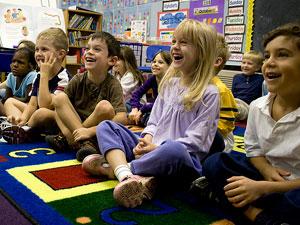Reviving America’s creativity
(Image by Flickr user woodleywonderworks (cc:by))
This story was originally covered by PRI’s Studio 360. For more, listen to the audio above.
From the oil spill in the Gulf to the wars in Iraq and Afghanistan, the United States is in desperate need of some creative thinking. At the same time, American children seem to be getting less creative. Though IQ scores have been steadily increasing for generations, tested creativity scores have been declining in America since 1990.
Part of the reason why creativity scores are dropping may be because “there’s no concerted effort to nurture the creativity of all children,” Po Bronson and Ashley Merryman write for Newsweek. Schools are focusing more on rote memorization and nationalized testing than instilling the value of creativity.
The problem in schools extends far beyond arts education, too. “Innovation is about the future and about growth, and that process of creativity isn’t something that is domain specific,” Merryman told PRI’s Studio 360. “It’s something that anyone can benefit from.”
Some argue that schools should spend their time teaching skills, rather than creativity. But Merryman and Bronson argue, “The argument that we can’t teach creativity because kids already have too much to learn is a false trade-off. Creativity isn’t about freedom from concrete facts. Rather, fact-finding and deep research are vital stages in the creative process.”
In fact, making time for creativity and play is an essential part of teaching vital skills like literacy, according to Lisa Guernsey in The American Prospect. Guernsey argues that “truly integrating playful learning and early-literacy instruction” is an accepted goal of many researchers. But real-world schools have been slow to catch up.
To get there, Guernsey writes that “teachers should be given the time and flexibility to plan and carry out creative projects,” instead of being forced to comply with strict testing and rote memorization. She quotes a letter from the Alliance for Childhood, arguing that some standards threaten to “[cut] off children’s initiative, curiosity, and imagination, limiting their later engagement in school and the workplace, not to mention responsible citizenship.”
Nurturing creativity among American children will take more than a class or two, according to Merryman. Schools will need to rethink how they approach the idea of creativity in children. She told Studio 360:
If you just teach kids, ‘this is creativity class. And in creativity class, we’re going to think about creativity and problem-solving techniques for 20 minutes.’ It doesn’t send them the message that these are useful tools in the rest of their day. And what we want to do is have them be able to bring those ideas throughout their learning. And not even just in walls of the classroom, but just how they approach their lives.
PRI’s Peabody Award-winning “Studio 360 with Kurt Andersen” from WNYC is public radio’s smart and surprising guide to what’s happening in pop culture and the arts. Each week, Kurt Andersen introduces you to the people who are creating and shaping our culture. Life is busy — so let “Studio 360” steer you to the must-see movie this weekend, the next book for your nightstand, or the song that will change your life.
